北京化工大学:《无机化学》课程电子教案(试卷习题)第十六-十七综合自我练习题及答案
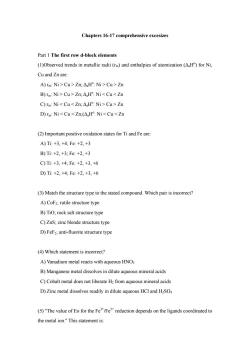
Chapters 16-17 comprehensive excesizes Part I The first row d-block elements (1)Observed trends in metallic radii (m)and enthalpies of atomization (H)for Ni Cu and Zn are: A)rm:Ni>Cu>Zn:A,H:Ni Cu>Zn B)rm:Ni>Cu>Zn;A.H:Ni Cu>Zn D)rm:Ni<Cu<Zn(AH°:Ni<Cu<Zn (2)Important positive oxidation states for Ti and Fe are A)Ti:+3,+4Fe:+2,+3 B)Ti:+2,+3;Fe:+2,+3 C)Ti:+3,+4:Fe:+2,+3,+6 D)Ti+2,+4:Fe:+2,+3,+6 (3)Match the structure type to the stated compound.Which pair is incorrect? A)CoF;rutile structure type B)TiO;rock salt structure type C)ZnS;zinc blende structure type D)FeF2;anti-fluorite structure type (4)Which statement is incorrect? A)Vanadium metal reacts with aqueous HNO3 B)Manganese metal dissolves in dilute aqueous mineral acids C)Cobalt metal does not liberate H2 from aqueous mineral acids D)Zinc metal dissolves readily in dilute aqueous HCl and H2SO (5)"The value of Eo for the Fe"/Fe2reduction depends on the ligands coordinated to the metal ion."This statement is:
Chapters 16-17 comprehensive excesizes Part 1 The first row d-block elements (1)Observed trends in metallic radii (rm) and enthalpies of atomization (ΔaHo ) for Ni, Cu and Zn are: A) rm: Ni > Cu > Zn; ΔaHo : Ni > Cu > Zn B) rm: Ni > Cu > Zn; ΔaHo : Ni Cu > Zn D) rm: Ni < Cu < Zn;(ΔaHo : Ni < Cu < Zn (2) Important positive oxidation states for Ti and Fe are: A) Ti: +3, +4; Fe: +2, +3 B) Ti: +2, +3; Fe: +2, +3 C) Ti: +3, +4; Fe: +2, +3, +6 D) Ti: +2, +4; Fe: +2, +3, +6 (3) Match the structure type to the stated compound. Which pair is incorrect? A) CoF2; rutile structure type B) TiO; rock salt structure type C) ZnS; zinc blende structure type D) FeF2; anti-fluorite structure type (4) Which statement is incorrect? A) Vanadium metal reacts with aqueous HNO3 B) Manganese metal dissolves in dilute aqueous mineral acids C) Cobalt metal does not liberate H2 from aqueous mineral acids D) Zinc metal dissolves readily in dilute aqueous HCl and H2SO4 (5) ''The value of Eo for the Fe3+/Fe2+ reduction depends on the ligands coordinated to the metal ion.'' This statement is: 1

A)false B)true,and reduction is made easier by replacing HO by bpy ligands C)true,and reduction is made harder by replacing H2O by phen ligands D)true.and reduction is made easier by replacing H2O by [CN]ligands (6)Match shape to formula.Which pair is incorrect? A)[FeCl];tetrahedral B)[NiBra];square planar C)[Ni(CN)4];square planar D)[Mn(N3)4];tetrahedral (7)Which statement about [Cr2(O2CR)]is incorrect? A)The Cr-Cr bond distance is approximately equal to twice the metallic radius of Cr B)The compound is diamagnetic C)The compound can interact with Lewis bases D)Each acetate ligand bridges the two Cr atoms (8)Match the solid state structural description to the formula.Which pair is incorrect? A)TiCl;tetrahedral molecules B)VFs;polymeric A)CrFs;trigonal bipyramidal molecules B)FeCls;3-dimensional structure (9)A salt Kn[MnF]has an observed magnetic moment of 4.9 uB.What are the oxidation state of Mn and the value of n? A)Mn(II):n=4 B)Mn(III);n=3 C)Mn(IV);n=2 D)Mn(V):n=1
A) false B) true, and reduction is made easier by replacing H2O by bpy ligands C) true, and reduction is made harder by replacing H2O by phen ligands D) true, and reduction is made easier by replacing H2O by [CN]– ligands (6) Match shape to formula. Which pair is incorrect? A) [FeCl4] 2–; tetrahedral B) [NiBr4] 2–; square planar C) [Ni(CN)4] 2–; square planar D) [Mn(N3)4] 2–; tetrahedral (7) Which statement about [Cr2(O2CR)4] is incorrect? A) The Cr–Cr bond distance is approximately equal to twice the metallic radius of Cr B) The compound is diamagnetic C) The compound can interact with Lewis bases D) Each acetate ligand bridges the two Cr atoms (8) Match the solid state structural description to the formula. Which pair is incorrect? A) TiCl4; tetrahedral molecules B) VF5; polymeric A) CrF5; trigonal bipyramidal molecules B) FeCl3; 3-dimensional structure (9) A salt Kn[MnF6] has an observed magnetic moment of 4.9 μB. What are the oxidation state of Mn and the value of n? A) Mn(II); n = 4 B) Mn(III); n = 3 C) Mn(IV); n = 2 D) Mn(V); n = 1 2
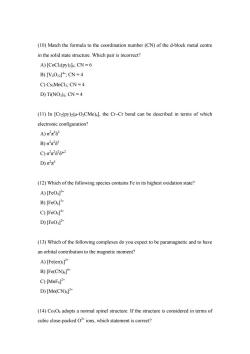
(10)Match the formula to the coordination number(CN)of the d-block metal centre in the solid state structure.Which pair is incorrect? A)[CoCl(py)]:CN=6 B)[V4O2],CN=4 C)Cs:MnCls;CN=4 D)Ti(NO3)4;CN=4 (11)In [Cr2(py)(H-OCMe)].the Cr-Cr bond can be described in terms of which electronic configuration? A)282 B)62x28 C)62x2828*2 D)62x (12)Which of the following species contains Fe in its highest oxidation state? A)[FeO B)FeO产 C)[FeO] D)[FeO3 (13)Which of the following complexes do you expect to be paramagnetic and to have an orbital contribution to the magnetic moment? A)[Fe(en)s B)[Fe(CN)] C)[MnFs]2- D)[Mn(CN)] (14)CoO adopts a normal spinel structure.If the structure is considered in terms of cubic close-packed-ions,which statement is correct?
(10) Match the formula to the coordination number (CN) of the d-block metal centre in the solid state structure. Which pair is incorrect? A) [CoCl2(py)2]n; CN = 6 B) [V4O12] 4–; CN = 4 C) Cs3MnCl5; CN = 4 D) Ti(NO3)4; CN = 4 (11) In [Cr2(py)2(μ-O2CMe)4], the Cr–Cr bond can be described in terms of which electronic configuration? A) σ 2 π 4 δ2 B) σ 2 π 2 δ2 C) σ 2 π 2 δ2 δ*2 D) σ 2 π 4 (12) Which of the following species contains Fe in its highest oxidation state? A) [FeO4] 2– B) [FeO4] 3– C) [FeO4] 4– D) [FeO3] 2– (13) Which of the following complexes do you expect to be paramagnetic and to have an orbital contribution to the magnetic moment? A) [Fe(en)3] 2+ B) [Fe(CN)6] 4– C) [MnF6] 2– D) [Mn(CN)6] 2– (14) Co3O4 adopts a normal spinel structure. If the structure is considered in terms of cubic close-packed O2– ions, which statement is correct? 3
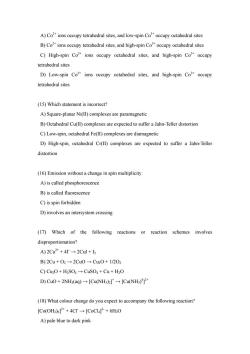
A)Coions occupy tetrahedral sites,and low-spin Cooccupy octahedral sites B)Coions occupy tetrahedral sites.and high-spin Cooccupy octahedral sites C)High-spin Co2 ions occupy octahedral sites,and high-spin Co*occupy tetrahedral sites D)Low-spin Co2+ions occupy octahedral sites,and high-spin Co occupy tetrahedral sites (15)Which statement is incorrect? A)Square-planar Ni(II)complexes are paramagnetic B)Octahedral Cu(I)complexes are expected to suffer a Jahn-Teller distortion C)Low-spin,octahedral Fe(II)complexes are diamagnetic D)High-spin,octahedral Cr(II)complexes are expected to suffer a Jahn-Teller distortion (16)Emission without a change in spin multiplicity: A)is called phosphorescence B)is called fluorescence C)is spin forbidden D)involves an intersystem crossing (17)Which of the following reactions or reaction schemes involves disproportionation? A)2Cu2++4→2Cul+2 B)2Cu+02→2Cu0→Cu20+1/202 C)Cu2O+H2SOa-CuSOa+Cu+H2O D)CuO+2NH(aq)→[CuNH2→[CuNH) (18)What colour change do you expect to accompany the following reaction? [Co(OH2)*+4Cr[CoCL]2+6H2O A)pale blue to dark pink
A) Co2+ ions occupy tetrahedral sites, and low-spin Co3+ occupy octahedral sites B) Co2+ ions occupy tetrahedral sites, and high-spin Co3+ occupy octahedral sites C) High-spin Co2+ ions occupy octahedral sites, and high-spin Co3+ occupy tetrahedral sites D) Low-spin Co2+ ions occupy octahedral sites, and high-spin Co3+ occupy tetrahedral sites (15) Which statement is incorrect? A) Square-planar Ni(II) complexes are paramagnetic B) Octahedral Cu(II) complexes are expected to suffer a Jahn-Teller distortion C) Low-spin, octahedral Fe(II) complexes are diamagnetic D) High-spin, octahedral Cr(II) complexes are expected to suffer a Jahn-Teller distortion (16) Emission without a change in spin multiplicity: A) is called phosphorescence B) is called fluorescence C) is spin forbidden D) involves an intersystem crossing (17) Which of the following reactions or reaction schemes involves disproportionation? A) 2Cu2+ + 4I- → 2CuI + I2 B) 2Cu + O2 → 2CuO → Cu2O + 1/2O2 C) Cu2O + H2SO4 → CuSO4 + Cu + H2O D) CuO + 2NH3(aq) → [Cu(NH3)2] + → [Cu(NH3) 4 ] 2+ (18) What colour change do you expect to accompany the following reaction? [Co(OH2)6] 2+ + 4Cl- → [CoCl4] 2- + 6H2O A) pale blue to dark pink 4

B)dark pink to deep purple C)pale pink to dark blue D)pale blue to dark blue (19)Which one of the following is expected to exhibit a Jahn-Teller distortion? A)[Cr(OH2)] B)[Mn(OH2)] C)[Mn(CN)] D)[Fe(CN) (20)Which of the following descriptions of the complex [Ni(Hdmg)]is the most appropriate?(H2dmg=dimethylglyoxime) A)Hydrogen-bonded pairs of ligands around square planar Ni(II);the complex is highly soluble in water B)Tetrahedral Ni(ID),the red complex has a low solubility in water C)Hydrogen-bonded pairs of ligands around square planar Ni(II);the red complex has a low solubility in water D)Tetrahedral Ni(l)the complex is highly soluble in water and gives red solutions Answer: 1.Correct Answer rmNiCu>Zn 2.Correct Answer: Ti:+3,+4,Fe+2,+3 3.Your Answer: FeF2,anti-fluorite structure type 4.Correct Answer: Cobalt metal does not liberate H2 from aqueous mineral acids 5.Correct Answer true,and reduction is made easier by replacing HO by bpy ligands
B) dark pink to deep purple C) pale pink to dark blue D) pale blue to dark blue (19) Which one of the following is expected to exhibit a Jahn-Teller distortion? A) [Cr(OH2)6] 3+ B) [Mn(OH2)6] 3+ C) [Mn(CN)6] 3- D) [Fe(CN)6] 2- (20) Which of the following descriptions of the complex [Ni(Hdmg)2] is the most appropriate? (H2dmg = dimethylglyoxime) A) Hydrogen-bonded pairs of ligands around square planar Ni(II); the complex is highly soluble in water B) Tetrahedral Ni(II); the red complex has a low solubility in water C) Hydrogen-bonded pairs of ligands around square planar Ni(II); the red complex has a low solubility in water D) Tetrahedral Ni(II); the complex is highly soluble in water and gives red solutions Answer: 1.Correct Answer: rm: Ni Cu > Zn 2.Correct Answer: Ti: +3, +4; Fe: +2, +3 3.Your Answer: FeF2; anti-fluorite structure type 4.Correct Answer: Cobalt metal does not liberate H2 from aqueous mineral acids 5.Correct Answer: true, and reduction is made easier by replacing H2O by bpy ligands 5
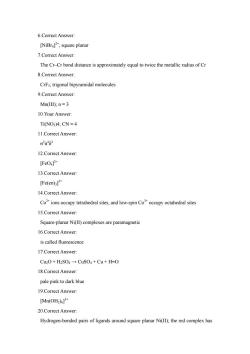
6.Correct Answer: [NiBra];square planar 7.Correct Answer The Cr-Cr bond distance is approximately equal to twice the metallic radius of Cr 8.Correct Answer: CrFs;trigonal bipyramidal molecules 9.Correct Answer Mn(III):n=3 10.Your Answer: Ti(NO3)4;CN=4 11.Correct Answer 62π482 12.Correct Answer: [FeO- 13.Correct Answer: [Fe(en) 14.Correct Answer: Coions occupy tetrahedral sites,and low-spin Cooccupy octahedral sites 15.Correct Answer: Square-planar Ni(II)complexes are paramagnetic 16.Correct Answer: is called fluorescence 17.Correct Answer: Cu2O+H2SO-CuSO4+Cu+H=O 18.Correct Answer pale pink to dark blue 19.Correct Answer: [Mn(OH2)+ 20.Correct Answer: Hydrogen-bonded pairs of ligands around square planar Ni(ID)the red complex has
6.Correct Answer: [NiBr4] 2–; square planar 7.Correct Answer: The Cr–Cr bond distance is approximately equal to twice the metallic radius of Cr 8.Correct Answer: CrF5; trigonal bipyramidal molecules 9.Correct Answer: Mn(III); n = 3 10.Your Answer: Ti(NO3)4; CN = 4 11.Correct Answer: σ 2 π 4 δ2 12.Correct Answer: [FeO4] 2– 13.Correct Answer: [Fe(en)3] 2+ 14.Correct Answer: Co2+ ions occupy tetrahedral sites, and low-spin Co3+ occupy octahedral sites 15.Correct Answer: Square-planar Ni(II) complexes are paramagnetic 16.Correct Answer: is called fluorescence 17.Correct Answer: Cu2O + H2SO4 → CuSO4 + Cu + H=O 18.Correct Answer: pale pink to dark blue 19.Correct Answer: [Mn(OH2)6] 3+ 20.Correct Answer: Hydrogen-bonded pairs of ligands around square planar Ni(II); the red complex has 6
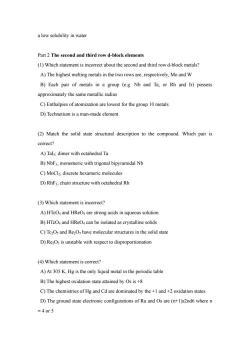
a low solubility in water Part 2 The second and third row d-block elements (1)Which statement is incorrect about the second and third row d-block metals? A)The highest melting metals in the two rows are,respectively,Mo and W B)Each pair of metals in a group (e.g.Nb and Ta,or Rh and Ir)possess approximately the same metallic radius C)Enthalpies of atomization are lowest for the group 10 metals D)Technetium is a man-made element (2)Match the solid state structural description to the compound.Which pair is correct? A)Tals;dimer with octahedral Ta B)NbFs,monomeric with trigonal bipyramidal Nb C)MoCl discrete hexameric molecules D)RhFs;chain structure with octahedral Rh ()Which statement is incorrect? A)HTcO and HReO4 are strong acids in aqueous solution B)HTcO and HReO4 can be isolated as crystalline solids C)Tc2Oand Re2O have molecular struetures in the solid state D)Re2Os is unstable with respect to disproportionation (4)Which statement is correct? A)At 305 K.Hg is the only liquid metal in the periodic table B)The highest oxidation state attained by Os is+8 C)The chemistries of Hg and Cd are dominated by the+1 and+2 oxidation states D)The ground state electronic configurations of Ru and Os are(n+1)s2nd6 where n =40r5
a low solubility in water Part 2 The second and third row d-block elements (1) Which statement is incorrect about the second and third row d-block metals? A) The highest melting metals in the two rows are, respectively, Mo and W B) Each pair of metals in a group (e.g. Nb and Ta, or Rh and Ir) possess approximately the same metallic radius C) Enthalpies of atomization are lowest for the group 10 metals D) Technetium is a man-made element (2) Match the solid state structural description to the compound. Which pair is correct? A) TaI5; dimer with octahedral Ta B) NbF5; monomeric with trigonal bipyramidal Nb C) MoCl2; discrete hexameric molecules D) RhF5; chain structure with octahedral Rh (3) Which statement is incorrect? A) HTcO4 and HReO4 are strong acids in aqueous solution B) HTcO4 and HReO4 can be isolated as crystalline solids C) Tc2O7 and Re2O7 have molecular structures in the solid state D) Re2O5 is unstable with respect to disproportionation (4) Which statement is correct? A) At 305 K, Hg is the only liquid metal in the periodic table B) The highest oxidation state attained by Os is +8 C) The chemistries of Hg and Cd are dominated by the +1 and +2 oxidation states D) The ground state electronic configurations of Ru and Os are (n+1)s2nd6 where n = 4 or 5 7
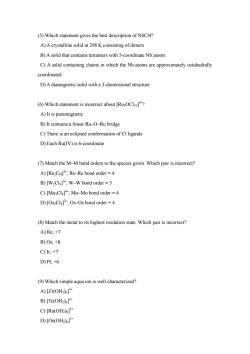
(5)Which statement gives the best description of NbCl4? A)A crystalline solid at 298 K consisting of dimers B)A solid that contains tetramers with 5-coordinate Nbatoms C)A solid containing chains in which the Nb atoms are approximately octahedrally coordinated D)A diamagnetic solid with a 3-dimensional structure (6)Which statement is incorrect about [RuzOClo? A)It is paramagnetic B)It contains a linear Ru-O-Ru bridge C)There is an eclipsed conformation of Cl ligands D)Each Ru(IV)is 6-coordinate (7)Match the M-M bond orders to the species given.Which pair is incorrect? A)[Re2Cis]-;Re-Re bond order=4 B)[W2Cl];W-W bond order=3 C)[Mo2Cls];Mo-Mo bond order =4 D)[Os2CIs]-;Os-Os bond order=4 (8)Match the metal to its highest oxidation state.Which pair is incorrect? A)Re;+7 B)Os;+8 C)Ir,+7 D)Pt:+6 (9)Which simple aqua ion is well characterized? A)[Zr(OH2)] B)[Tc(OH2)6] C)[Ru(OH2)] D)[Os(OH2)]
(5) Which statement gives the best description of NbCl4? A) A crystalline solid at 298 K consisting of dimers B) A solid that contains tetramers with 5-coordinate Nb atoms C) A solid containing chains in which the Nb atoms are approximately octahedrally coordinated D) A diamagnetic solid with a 3-dimensional structure (6) Which statement is incorrect about [Ru2OCl10] 4–? A) It is paramagnetic B) It contains a linear Ru–O–Ru bridge C) There is an eclipsed conformation of Cl ligands D) Each Ru(IV) is 6-coordinate (7) Match the M–M bond orders to the species given. Which pair is incorrect? A) [Re2Cl8] 2–; Re–Re bond order = 4 B) [W2Cl9] 3–; W–W bond order = 3 C) [Mo2Cl8] 4–; Mo–Mo bond order = 4 D) [Os2Cl8] 2–; Os–Os bond order = 4 (8) Match the metal to its highest oxidation state. Which pair is incorrect? A) Re; +7 B) Os; +8 C) Ir; +7 D) Pt; +6 (9) Which simple aqua ion is well characterized? A) [Zr(OH2)6] 4+ B) [Tc(OH2)6] 3+ C) [Ru(OH2)6] 3+ D) [Os(OH2)6] 3+ 8
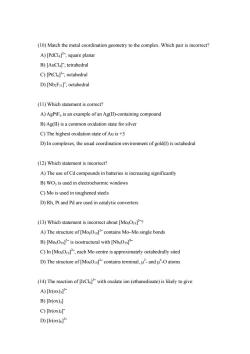
(10)Match the metal coordination geometry to the complex.Which pair is incorrect? A)[PdCl square planar B)[AuC tetrahedral C)[PtCl2;octahedral D)[Nb2Fu;octahedral (11)Which statement is correct? A)AgPtFs is an example of an Ag(II)-containing compound B)Ag(II)is a common oxidation state for silver C)The highest oxidation state of Au is+3 D)In complexes,the usual coordination environment of gold(I)is octahedral (12)Which statement is incorrect? A)The use of Cd compounds in batteries is increasing significantly B)WO;is used in electrochormic windows C)Mo is used in toughened steels D)Rh,Pt and Pd are used in catalytic converters (13)Which statement is incorrect about [Mo6O? A)The structure of [MoOcontains Mo-Mo single bonds B)[MoOis isostructural with [NbO C)In [Mo,each Mo centre is approximately octahedrally sited D)The structure of[MosO1g2-contains terminal,μ2.andμ°-O atoms (14)The reaction of [oxalate ion(ethanedioate)is likely to give: A)lr(ox]产 B)[Ir(ox)3] C)[Ir(ox) D)[Ir(ox)]
(10) Match the metal coordination geometry to the complex. Which pair is incorrect? A) [PdCl4] 2–; square planar B) [AuCl4] – ; tetrahedral C) [PtCl6] 2–; octahedral D) [Nb2F11] – ; octahedral (11) Which statement is correct? A) AgPtF6 is an example of an Ag(II)-containing compound B) Ag(II) is a common oxidation state for silver C) The highest oxidation state of Au is +3 D) In complexes, the usual coordination environment of gold(I) is octahedral (12) Which statement is incorrect? A) The use of Cd compounds in batteries is increasing significantly B) WO3 is used in electrochormic windows C) Mo is used in toughened steels D) Rh, Pt and Pd are used in catalytic converters (13) Which statement is incorrect about [Mo6O19] 2–? A) The structure of [Mo6O19] 2– contains Mo–Mo single bonds B) [Mo6O19] 2– is isostructural with [Nb6O19] 8– C) In [Mo6O19] 2–, each Mo centre is approximately octahedrally sited D) The structure of [Mo6O19] 2– contains terminal, μ 2 - and μ6 -O atoms (14) The reaction of [IrCl6] 3– with oxalate ion (ethanedioate) is likely to give: A) [Ir(ox)3] 3– B) [Ir(ox)3] C) [Ir(ox)2] – D) [Ir(ox)6] 3– 9
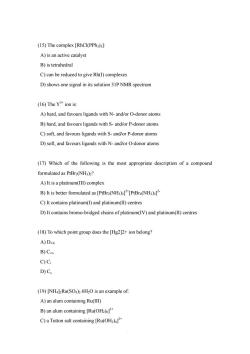
(15)The complex [RhCI(PPh3)3]: A)is an active catalyst B)is tetrahedral C)can be reduced to give Rh(I)complexes D)shows one signal in its solution 31P NMR spectrum (16)The Y3 ion is: A)hard,and favours ligands with N-and/or O-donor atoms B)hard,and favours ligands with S-and/or P-donor atoms C)soft,and favours ligands with S-and/or P-donor atoms D)soft,and favours ligands with N-and/or O-donor atoms (17)Which of the following is the most appropriate description of a compound formulated as PtBra(NH3)2? A)It is a platinum(III)complex B)It is better formulated as [PtBr2(NH3)2][PtBra(NH3)2 C)It contains platinum()and platinum(I)centres D)It contains bromo-bridged chains of platinum(IV)and platinum(II)centres (18)To which point group does the [Hg2]2+ion belong? A)Dch B)Cv c)Ci D)C, (19)[NH4]2Ru(SO4)2.6H2O is an example of: A)an alum containing Ru(I⑩) B)an alum containing [Ru(OH2) C)a Tutton salt containing [Ru(OH2)
(15) The complex [RhCl(PPh3)3]: A) is an active catalyst B) is tetrahedral C) can be reduced to give Rh(I) complexes D) shows one signal in its solution 31P NMR spectrum (16) The Y3+ ion is: A) hard, and favours ligands with N- and/or O-donor atoms B) hard, and favours ligands with S- and/or P-donor atoms C) soft, and favours ligands with S- and/or P-donor atoms D) soft, and favours ligands with N- and/or O-donor atoms (17) Which of the following is the most appropriate description of a compound formulated as PtBr3(NH3)2? A) It is a platinum(III) complex B) It is better formulated as [PtBr2(NH3)2] 2+[PtBr4(NH3)2] 2- C) It contains platinum(I) and platinum(II) centres D) It contains bromo-bridged chains of platinum(IV) and platinum(II) centres (18) To which point group does the [Hg2]2+ ion belong? A) D∞h B) C∞v C) Ci D) Cs (19) [NH4]2Ru(SO4)2.6H2O is an example of: A) an alum containing Ru(III) B) an alum containing [Ru(OH2)6] 2+ C) a Tutton salt containing [Ru(OH2)6] 2+ 10
按次数下载不扣除下载券;
注册用户24小时内重复下载只扣除一次;
顺序:VIP每日次数-->可用次数-->下载券;
- 北京化工大学:《无机化学》课程电子教案(试卷习题)第十六章自我练习题及答案.pdf
- 北京化工大学:《无机化学》课程电子教案(试卷习题)第十七章自我练习题及答案.pdf
- 北京化工大学:《无机化学》课程电子教案(试卷习题)第十五章自我练习题及答案.pdf
- 北京化工大学:《无机化学》课程电子教案(试卷习题)第十三-十四章综合自我练习题及答案.pdf
- 北京化工大学:《无机化学》课程电子教案(试卷习题)第十四章自我练习题及答案.pdf
- 北京化工大学:《无机化学》课程电子教案(试卷习题)第十二章自我练习题及答案.pdf
- 北京化工大学:《无机化学》课程电子教案(试卷习题)第十三章自我练习题及答案.pdf
- 北京化工大学:《无机化学》课程电子教案(试卷习题)第十章自我练习题及答案.pdf
- 北京化工大学:《无机化学》课程电子教案(试卷习题)第十一章自我练习题及答案.pdf
- 北京化工大学:《无机化学》课程电子教案(试卷习题)第八章自我练习题及答案.pdf
- 北京化工大学:《无机化学》课程电子教案(试卷习题)第九章自我练习题及答案.pdf
- 北京化工大学:《无机化学》课程电子教案(试卷习题)第七章自我练习题及答案.pdf
- 北京化工大学:《无机化学》课程电子教案(试卷习题)第四章自我练习题及答案.pdf
- 北京化工大学:《无机化学》课程电子教案(试卷习题)第六章自我练习题及答案.pdf
- 北京化工大学:《无机化学》课程电子教案(试卷习题)第五章自我练习题及答案.pdf
- 北京化工大学:《无机化学》课程电子教案(试卷习题)第二章自我练习题及答案.pdf
- 北京化工大学:《无机化学》课程电子教案(试卷习题)第三章自我练习题及答案.pdf
- 北京化工大学:《无机化学》课程电子教案(试卷习题)作业习题(中英文)安排及部分答案.pdf
- 北京化工大学:《无机化学》课程电子教案(试卷习题)自测题及答案-9.pdf
- 北京化工大学:《无机化学》课程电子教案(试卷习题)自测题及答案-8.pdf
- 北京化工大学:《无机化学》课程电子教案(教学课件,2011)Chapter 01 前言 Preface(负责人:周云山).pdf
- 北京化工大学:《无机化学》课程电子教案(教学课件,2011)Chapter 02 Thermochemistry.pdf
- 北京化工大学:《无机化学》课程电子教案(教学课件,2011)Chapter 03 Chemical kinetics.pdf
- 北京化工大学:《无机化学》课程电子教案(教学课件,2011)Chapter 05 Acid-Base Equilibrium.pdf
- 北京化工大学:《无机化学》课程电子教案(教学课件,2011)Chapter 04 Chemical equilibria, entropy and Gibbs function.pdf
- 北京化工大学:《无机化学》课程电子教案(教学课件,2011)Chapter 10 Solid Structure.pdf
- 北京化工大学:《无机化学》课程电子教案(教学课件,2011)Chapter 11 Coordination Compound Structures.pdf
- 北京化工大学:《无机化学》课程电子教案(教学课件,2011)Chapter 12 The s-Block Elements.pdf
- 北京化工大学:《无机化学》课程电子教案(教学课件,2011)Chapter 06 Precipitation-Solubility Equilibria.pdf
- 北京化工大学:《无机化学》课程电子教案(教学课件,2011)Chapter 08 Atomic Structure.pdf
- 北京化工大学:《无机化学》课程电子教案(教学课件,2011)Chapter 13 The p-block elements(Ⅰ).pdf
- 北京化工大学:《无机化学》课程电子教案(教学课件,2011)Chapter 07 Redox Reactions and Base of Electrochemistry.pdf
- 北京化工大学:《无机化学》课程电子教案(教学课件,2011)Chapter 09 Molecular Structure.pdf
- 北京化工大学:《无机化学》课程电子教案(教学课件,2011)Chapter 17 The d-block elements(Ⅱ).pdf
- 北京化工大学:《无机化学》课程电子教案(教学课件,2011)Chapter 14 p-block elements(Ⅱ).pdf
- 北京化工大学:《无机化学》课程电子教案(教学课件,2011)Chapter 15 p-block elements(Ⅲ).pdf
- 北京化工大学:《无机化学》课程电子教案(教学课件,2011)Chapter 16 The d-block elements(Ⅰ).pdf
- 北京化工大学:《无机化学》课程电子教案(教学课件,2012)Chapter 2 Thermochemistry.pdf
- 北京化工大学:《无机化学》课程电子教案(教学课件,2012)Chapter 5 Acid-Base Equilibrium.pdf
- 北京化工大学:《无机化学》课程电子教案(教学课件,2012)Chapter 6 Precipitation-Solubility Equilibria.pdf
